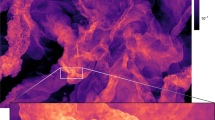Abstract
The interaction of an astrophysical shock with a cloud typically occurs at high Reynolds number, and in such cases will be highly turbulent. However, the formation of fully developed turbulence is usually prevented by the artificial viscosity inherent in hydrodynamical simulations. Upstream structures mean that the flow behind the shock is also likely to be turbulent, as it sweeps over such inhomogeneities. We study the nature of adiabatic shock-cloud interactions using a subgrid compressible k–ε turbulence model.
Similar content being viewed by others
References
Cecil, G., Bland-Hawthorn, J., Veilleux, S.: Astrophys. J. 576, 745 (2002)
Conselice, C.J., Gallagher, J.S., Wyse, R.F.G.: Astrophys. J. 122, 2281 (2001)
Danforth, C.W., Blair, W.P., Raymond, J.C.: Astron. J. 122, 938 (2001)
Hartquist, T.W., Dyson, J.E., Pettini, M., Smith, L.J.: Mon. Not. R. Astron. Soc. 221, 715 (1986)
Klein, R.I., McKee, C.F., Colella, P.: Astrophys. J. 420, 213 (1994)
Levenson, N.A., Graham, J.R., Walters, J.L.: Astrophys. J. 576, 798 (2002)
Martin, D.C., et al.: Nature 448, 780 (2007)
Matsuura, M., et al.: Astrophys. J. 700, 1067 (2009)
Nakamura, F., McKee, C.F., Klein, R.I., Fisher, R.T.: Astrophys. J. Suppl. 164, 477 (2006)
Pittard, J.M., Dyson, J.E., Falle, S.A.E.G., Hartquist: Mon. Not. R. Astron. Soc. 361, 1077 (2005)
Pittard, J.M., Falle, S.A.E.G., Hartquist, T.W., Dyson, J.E.: Mon. Not. R. Astron. Soc. 394, 1351 (2009)
Pittard, J.M., Hartquist, T.W., Falle, S.A.E.G.: Mon. Not. R. Astron. Soc. 405, 821 (2010)
Poludnenko, A.Y., Frank, A., Blackman, E.G.: Astrophys. J. 576, 832 (2002)
Shin, M.-S., Stone, J.M., Snyder, G.F.: Astrophys. J. 680, 336 (2008)
Strickland, D.K., Heckman, T.M., Weaver, K.A., Dahlem, M.: Astron. J. 120, 2965 (2000)
Veilleux, S., Cecil, G., Bland-Hawthorn, J.: Annu. Rev. Astron. Astrophys. 43, 769 (2005)
Westmoquette, M.S., Smith, L.J., Gallagher, J.S. III, O’Connell, R.W., Rosario, D.J., De Grijs, R.: Astrophys. J. 671, 358 (2007)
Westmoquette, M.S., Gallagher, J.S., Smith, L.J., Trancho, G., Bastian, N., Konstantopoulos, I.S.: Astrophys. J. 706, 1571 (2009). arXiv:0907.3162
Yirak, K., Frank, A., Cunningham, A.J.: Astrophys. J. 722, 412 (2010). arXiv:0912.4777
Author information
Authors and Affiliations
Corresponding author
Rights and permissions
About this article
Cite this article
Pittard, J.M., Hartquist, T.W., Dyson, J.E. et al. The turbulent destruction of interstellar clouds. Astrophys Space Sci 336, 239–244 (2011). https://doi.org/10.1007/s10509-010-0526-4
Received:
Accepted:
Published:
Issue Date:
DOI: https://doi.org/10.1007/s10509-010-0526-4



